
Although Google has over 200 ranking factors, backlinks are still one of the most important things to get right if you want to rank higher in search engine results.
Rather than having many low-quality links, high-quality backlinks are what move the needle in today’s search engine optimization (SEO) landscape.
The days of spammy link blasts or dodgy directories are gone. Google’s algorithm is more intelligent than ever and is laser-focused on rewarding sites that earn links from reputable, relevant sources. In other words, quality beats quantity every time.
Whether you’re building links in-house or working with an agency, understanding the difference between average and high-quality backlinks is key to building sustainable search visibility.
In this article, we’ll explain what makes a high-quality backlink, why these links are so valuable, and how to earn them the right way.
What Are High-Quality Backlinks?
The number of links pointing to your website is one of the most critical factors for driving traffic. That’s because the more backlinks your website has, the better your chances of ranking in Google’s search engine results pages (SERPs).
But not all backlinks are created equal. In fact, over 93% of link builders say quality is more important than link quantity.
High-quality backlinks are:
Earned.
Relevant.
From high-authority, trusted websites.
The best way to build high-quality backlinks is to use white hat link-building techniques that adhere to Google’s guidelines.

Buying links, using link-building schemes, or engaging in other black or gray-hat link-building techniques will result in building a backlink profile filled with spammy links.
While it might be tempting to take shortcuts, these tactics can backfire. Black-hat link-building techniques go against Google’s policies, and your website could get hit with a penalty if you’re caught using them.
Generating high-quality backlinks will take longer but will drive more traffic to your site in the long run.
What Are Black and Gray-Hat Techniques?
Black-hat links: These techniques, such as using private blog networks (PBNs) or leaving spam comments, blatantly break Google's rules. They might give you a quick boost but can also lead to severe penalties that tank your search engine rankings.
Grey-hat links: These are not outright forbidden by Google but can be seen as manipulative. One example is links pointing to your site from guest posts. While it’s not as risky as black-hat techniques, it can still carry some danger if overused or if you build backlinks with low-quality sites. More on this later!
There are three main factors you need to understand about high-quality backlinks before you can start building them:
1️⃣ High-quality backlinks are ‘earned’
You’ll never directly pay for quality backlinks. The owner of the linking website should have chosen to link to your content because it offers value.
Paying for links or manipulating a website owner to insert them is against Google’s rules. By using these tactics, you are trying to trick search engines into thinking that your content is more respected than it is.
Most of the time, Google will simply ignore links that it thinks have been purchased. In some cases, however, it may issue you a penalty.
The only time that you might pay for links is when using a link-building service like ours. In this case, you haven’t paid for the link directly. Instead, you have paid for someone to find opportunities to build quality backlinks on your behalf.

2️⃣ High-quality backlinks come from relevant sites
Search engines assess the websites and pages that link to your website to check that the subject matter matches. This ensures that the link has been made naturally.
Imagine if your website is about guitar lessons, and you have two links to your home page. One is from a local guitar shop, and the other is from a travel blog.
The guitar shop’s website is highly relevant to what you do and would be considered a good quality link by the search engine.
If a backlink is completely irrelevant, like the travel blog one in this scenario, Google may decide that you purchased it or got it through a link-building scheme, in which case it would be ignored.

3️⃣ Quality backlinks come from high-authority sites
Most SEO tools, such as Semrush, Moz, and Ahrefs, assign every website an authority score between one and 100.
This rating reflects the website’s reputation as a thought leader or a source of valuable content in its niche or industry.
Authority scores, such as domain authority (DA), domain rating (DR), or page authority (PA), are primarily based on the number and quality of backlinks your site has.
Understanding DA, PA, and DR
Domain authority (DA), domain rating (DR), and page authority (PA) are metrics that reflect a website's strength and credibility in search engines.
Developed by Moz (DA and PA) and Ahrefs (DR), these metrics range from one to 100. The higher the score, the more authority a website has.
In addition to identifying sites with high DA, PA, or DR, you should also consider their relevance to your niche and the quality of their content.
If your website has many backlinks from high-authority websites, Google is likely to rank it higher on the SERPs.

That’s because these backlinks tell Google’s algorithm that many authoritative sources trust your website.
High authority doesn’t define a quality backlink. Plenty of websites use their high authority to sell links. This link trading is against Google’s policy, and any link generated this way isn’t a quality backlink.
Again, Google will ignore a link if it thinks it isn’t earned or relevant, no matter how high the authority score.
Equally, low-authority links are not necessarily poor quality. If you have earned a backlink from a relevant website with low authority, it may still improve your ranking, but not as much as one from a relevant, high-authority site would.
How to Get Quality Backlinks with Link Building
There are several ways to earn and create high-quality backlinks for your website. These include:
1) Generate PR backlinks through campaigns
PR backlinks, sometimes known as PR outreach, are some of the most coveted links in SEO. These links are earned through your public relations efforts.
For example, let’s say you create a compelling story about a study your company conducted. You pitch it to several top-tier news outlets, and one of them publishes an article that links back to your website.
This earned backlink will significantly impact your site’s authority because it comes from a highly respected source.
Here’s why PR backlinks are so coveted. They are:
Natural: They’re earned organically without resorting to paid or manipulative tactics.
Earned from campaigns: They come from engaging, valuable campaigns that grab media attention.
From high-authority sites: They typically come from reputable news websites and major publications, which gives your site a serious credibility boost.
But there is a downside: these backlinks can be incredibly difficult to earn. Journalists and editors are flooded with pitches, which makes it tough to stand out from the crowd. Additionally, creating a truly attention-grabbing piece of content requires time and resources.
There’s also no guarantee that your pitch will be successful. Journalists are inundated with great content from businesses, so yours might be rejected even if it’s good.
➡️ How to get PR backlinks
Below are some steps to take to build high-quality PR backlinks:
Come up with a campaign idea
Think about what makes your business or product special. Is there a unique story or angle that hasn't been covered before? Maybe your company has an inspiring origin, or you've developed a product that solves a common problem in a new way.
Look at what's trending in your industry and whether you can tie your campaign idea to a current event or popular topic.
For example, if there’s a growing interest in sustainable practices, you could highlight your company’s eco-friendly initiatives.
Research publications
First, make a list of publications that are relevant to your industry and have a high authority.
Start by searching Google for key phrases related to your industry, such as "top blogs," "top news sites," or "industry publications."
For example, if you’re in the tech industry, you might search for "top tech blogs" or "best technology news sites”.
Look at the first few pages of the search results and compile a list of publications that appear frequently. Then, check their authority with tools like Ahrefs, Moz, or Semrush, and prioritize those with high authority.
Reach out to them
You can use the target publication’s social media pages, such as LinkedIn and X (formerly Twitter), to find contact information if you can’t find it on their website.
Once you know which publications you want to target, write a concise, engaging pitch that clearly explains the value of your story.
Start with a strong hook to grab the journalist’s attention. For example, "Did you know our new study reveals surprising trends in eco-friendly consumer behavior?"
Mention something specific about the journalist’s previous work or the publication’s recent articles to show that you’ve done your homework.
If you don’t hear back after a week, send a polite follow-up email. Sometimes, a well-timed reminder can make all the difference.
Another way to get PR backlinks is to send your story to an automated press release service. While your content has a good chance of being published, Google’s algorithms will quickly detect whether or not these types of publishing websites are relevant or high-quality.
Being published on these websites will not help you get quality backlinks.
➡️ An example of an effective PR campaign
An excellent example is a campaign we created for the Accounting Institute for Success. We created a timeline of tax evasion claims related to Donald Trump. This took some intensive research and design work, but it paid off.
At the time, Trump was in his first term as the President of the U.S., so we were able to build high-quality backlinks from authoritative sites like Slashdot and Mashable:
Good PR campaigns require creativity and perseverance. You might have to try a few ideas that don’t work at first. Read our article on how we achieve getting PR backlinks for more insights.
2) Create Linkable Assets
Linkable assets are content or resources that are so good that other websites will want to link to them. This is also known as creating link-worthy content, and it makes them excellent sources of quality links.
Good Linkable Content Has a Practical Use and Long-Term Value
This can include:
Reports and original research.
Statistics lists.
Online tools.
Guides.
Resource roundups.
➡️ How to create linkable assets
Here’s how to create a linkable asset that will earn you backlinks:
Research your audience
Use tools like Google Keyword Planner, Ahrefs, or Semrush to discover what keywords and topics your audience is searching for.
Don’t just look at the relevant keywords, ask yourself which specific problems people are trying to solve with these searches, and think about how you can create content that answers their questions.
You can go a step further by engaging with your audience through surveys, social media, and forums. Ask open-ended questions to understand their pain points and needs.
Analyze competitor links
A link intersect analysis shows you which websites are linking to your competitors but not to you.
Knowing this is valuable because it highlights potential link opportunities with quality websites that are already interested in content similar to yours.
If these websites find your competitors’ content valuable, there’s a good chance they might link to your content as well, provided it offers equal or greater value.
To perform a link intersect, go to Ahrefs, then go to the "Link intersect" tool:
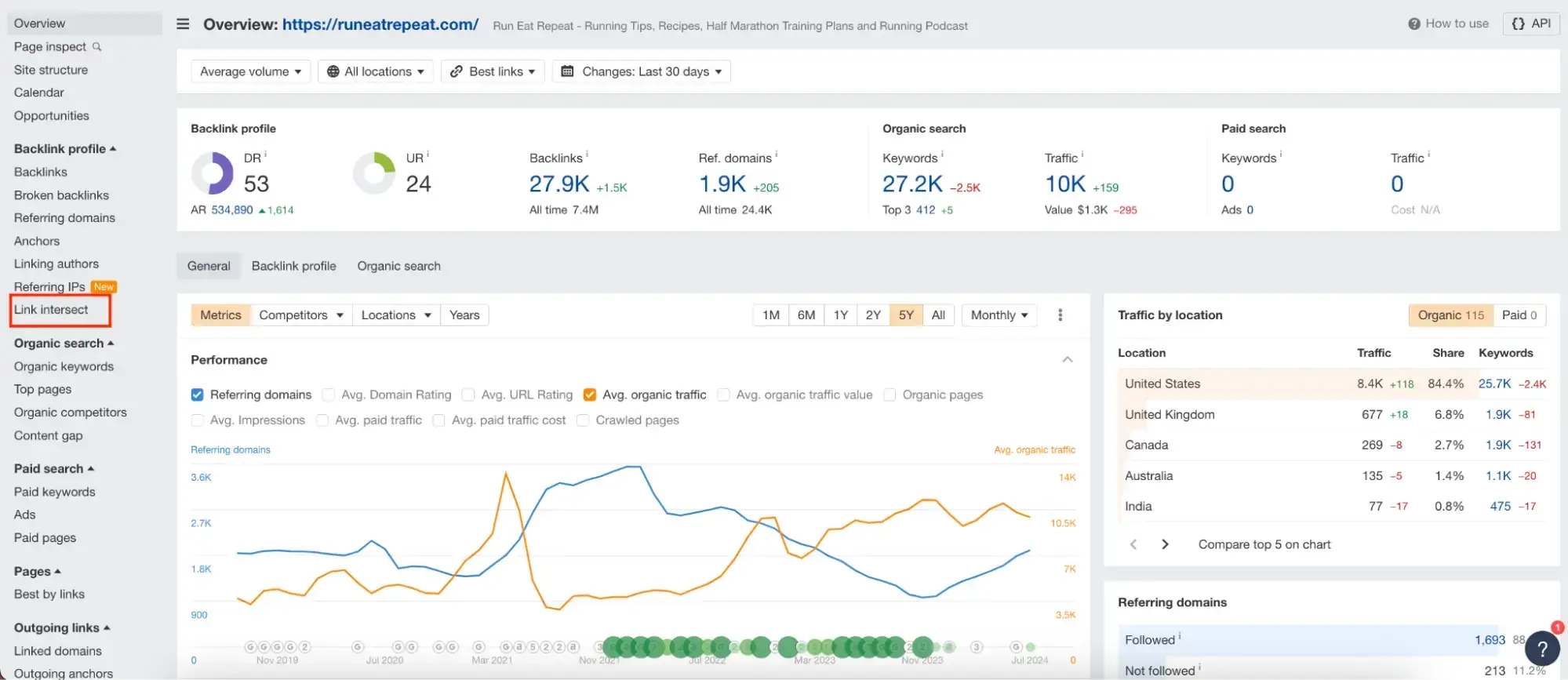
Enter your competitors' URLs:
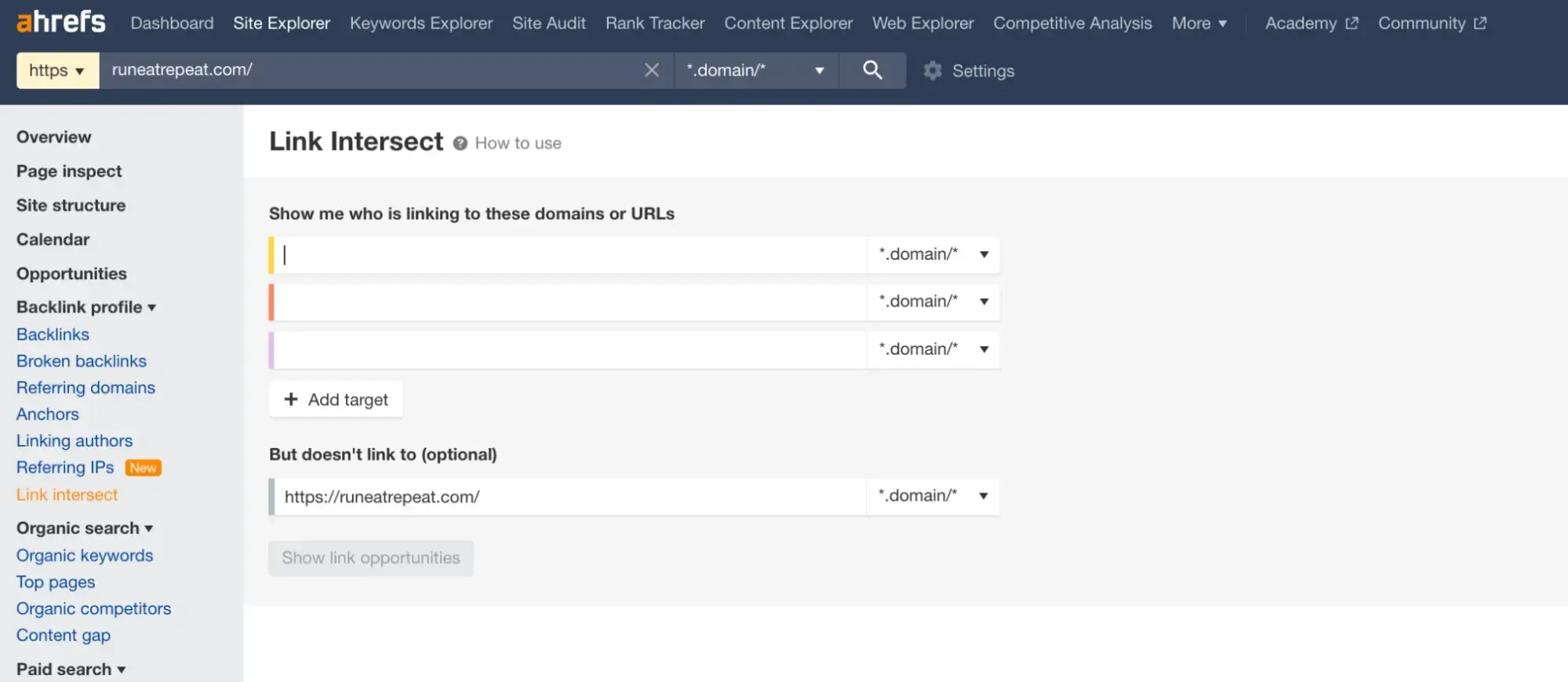
Ahrefs will show you all the URLs that are linking to your competitors, but not to you:
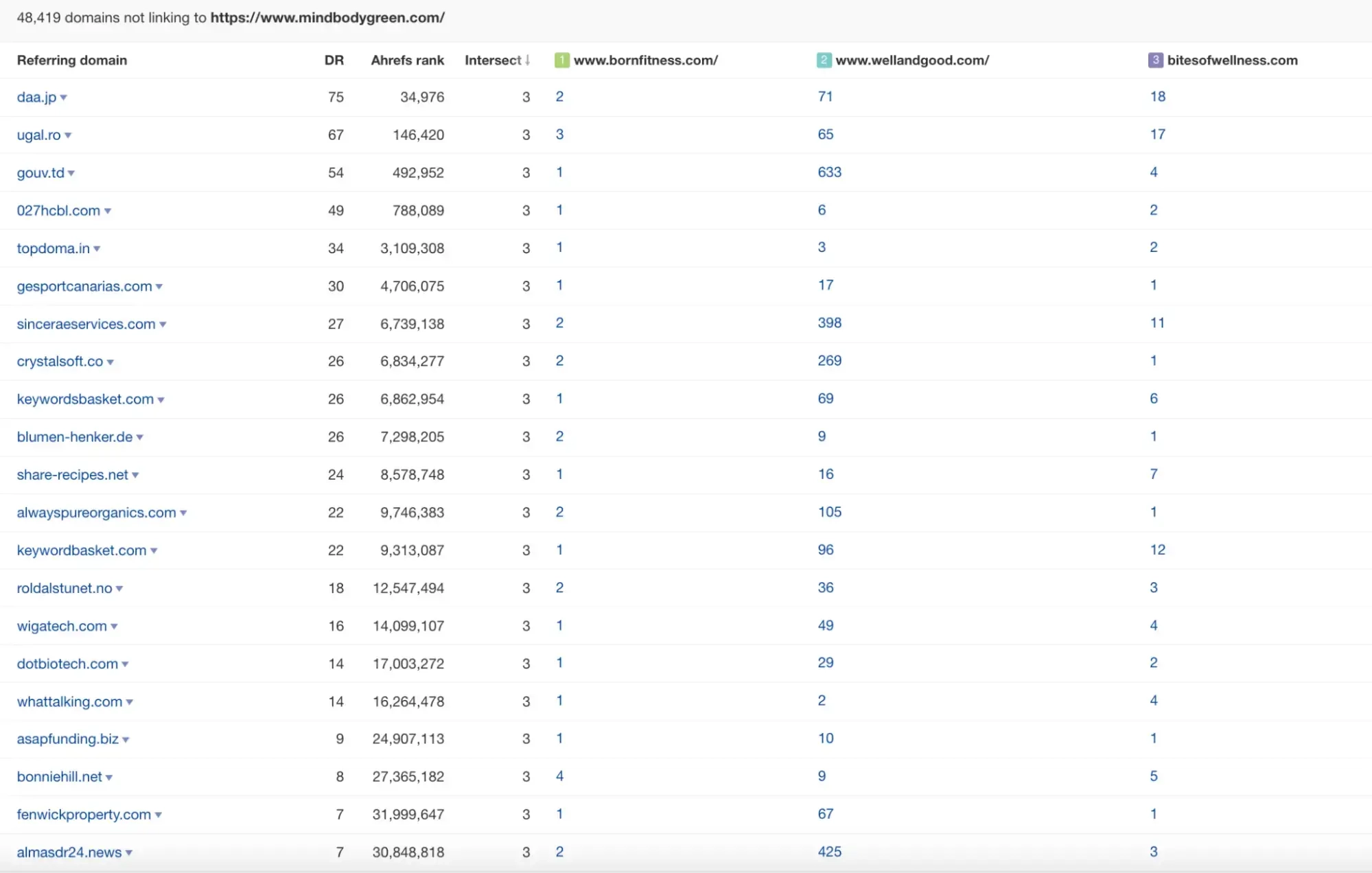
Now that you have a list of websites that link to your competitors, it’s time to create content that could get them to link to your website, too.
Come up with a great piece of content
Ask yourself what types of content attract the most links for your competitors. Can you create a similar or improved version of this content?
Think about unique angles or stories that haven’t been covered extensively. Consider creating in-depth guides and innovative online tools or conduct original research.
For example, if you notice an information gap in existing guides on vegan bodybuilding, you could create a detailed guide that covers vegan diets, dedicated workouts for vegans, and success stories.
Look at your competitors' successful linkable assets and consider how to improve them. Update outdated information, add more value, or present it in a more engaging way.
Share your content
Like PR backlinks, linkable asset campaigns involve outreach to obtain backlinks.
But this time, you’ll reach out to other blogs and websites rather than publications.
Avoid contacting link farms, PBNs, and other link-building scams, as these won’t result in quality backlinks.
The websites you contact might ask you for payment for a link. Paying for links is against Google’s guidelines but is standard practice in some industries. It is up to you whether you want to do this.
➡️ An example of an effective linkable asset
We managed a great linkable content campaign for our client, Identity Guard.
We researched ideas that would be useful for Identity Guard’s industry and draw significant search traffic. We came up with the concept of dark web monitoring.
The dark web is a hidden part of the Internet that is not indexed by search engines and accessible only through special browsers like Tor.
Cybersecurity is a hot topic, with frequent news about hacks and data breaches. We quickly realized that dark web monitoring taps into this relevance and makes it a topic of interest to readers.
3) Attract Image Links
Image link building is a long-term strategy but will attract quality links if done correctly. Best of all, it’s passive and requires little effort once set up.
Image link building is when you create quality, relevant images that people want to share or use.
For this strategy to be successful, you need to set up your images so that a link to your website is published when someone shares them.
The types of images that people like to share include:
Infographics.
Logos, badges, and banners.
Product photos.
Graphs, charts, and statistics.
Maps.
Below is a great example of an infographic from social media management platform Hootsuite. It has received over 1,400 backlinks:
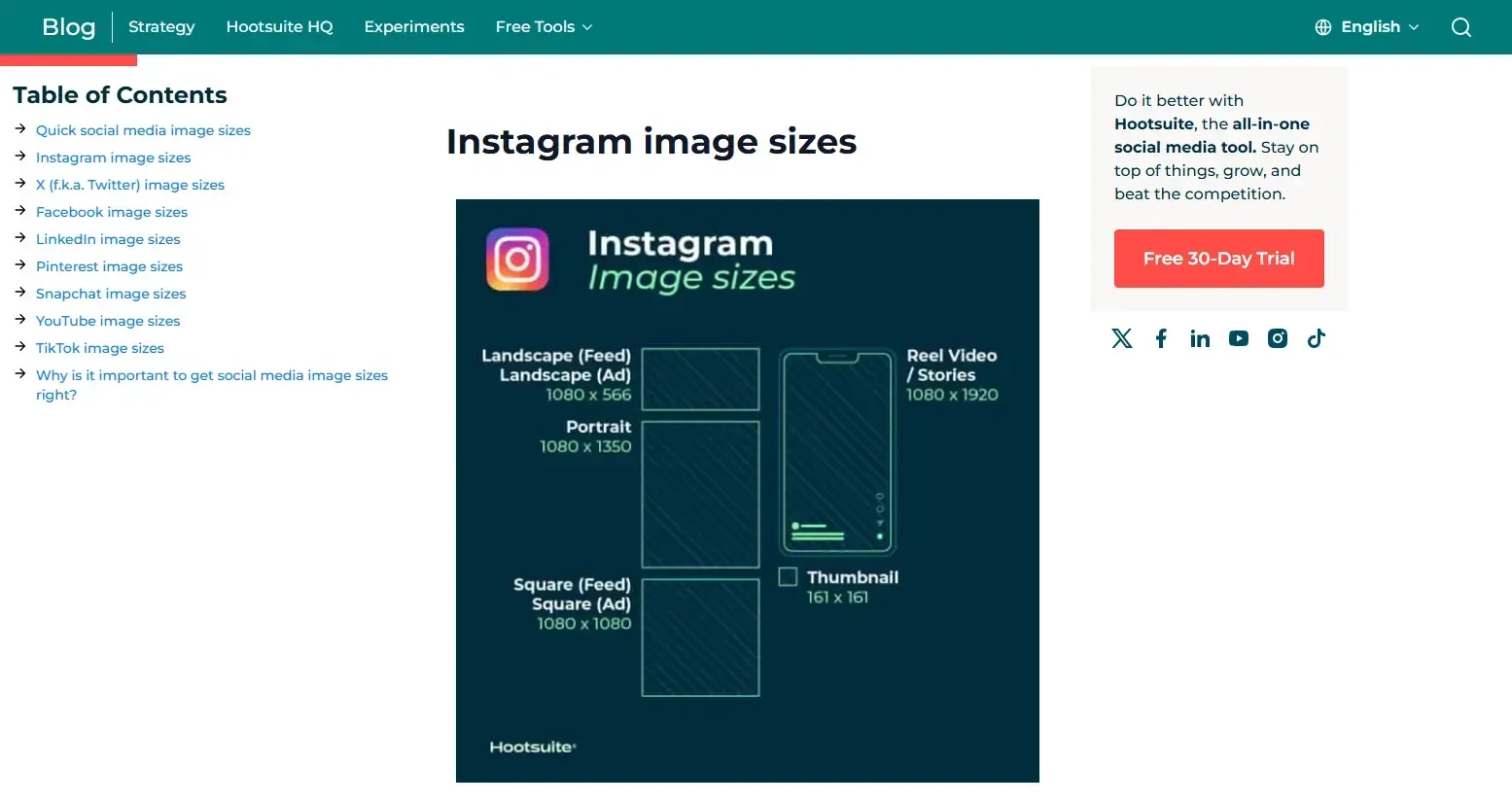
How to set up an image link building campaign
Below are some steps to take to create an image link building campaign:
1. Analyze competitor images: Keep an eye on what works for your competitors all year round. This will give you a sense of the images that will work for your campaigns.
2. Use Google Trends: Leveraging Google Trends is a great way to see what kind of image content people are interested in sharing.
3. Narrow your search: Use tools like AnswerThePublic and Keywordtool.io to narrow down your list of relevant keywords. Both of these tools have free and paid-for versions.
4. Use keywords with link intent: Look up your long-tail keywords on Google and find images that could work for your niche. Find out who links to these images and target these websites with an outreach campaign.
5. Create unbranded images: The people using your images are not interested in promoting your brand. They’ll probably steer clear of branded images, as it will make their content appear as if it’s sponsored by you.
6. Optimize your images: This involves adding relevant titles that include your keywords for image fields. This will help Google understand what the image is. These fields include:
Alt text: Use this to describe the image. If the image is of a woman sitting at a desk typing on a laptop, your alt text could be: "Woman working on a laptop at a desk with a coffee cup beside her."
Title: A short explanation of the image that includes keywords. Let’s say you have an image of someone organizing files in a home office. A good title would be “Home office organization with labeled file folders”.
Image filename: Again, use keywords. Instead of using something like “IMG_1234.jpg,” use a descriptive file name like “woman-typing-on-laptop-coffee-desk.jpg”.
Caption: Use this to help website visitors understand your content. If your image is someone sorting paperwork at a desk, your caption could be: “Organizing documents in a home office using clearly labeled file folders for better productivity.”
7. Create a URL for your image: This is the essential part. You must create an image URL to link back to your website. We recommend using imgur.com to do this. Read our guide to image link building for more information.
4) Leverage Qwoted
One of the easiest and most effective ways to get high-quality links is to use Qwoted. This is a service that connects writers who are looking for experts with people who can help answer their questions.

If you provide a writer with information that helps them write their article, they may include a link to your website when it is published. This means that links from Qwoted responses are relevant and earned.
Here’s how it works
Create a comprehensive profile: Begin by setting up a detailed profile on the platform. Include your professional credentials, areas of expertise, and contact information. A well-crafted profile increases your chances of journalists reaching out to you for relevant opportunities.
Monitor and respond to writer queries: Regularly check the platform for media requests that align with your expertise. When you find a relevant query, respond promptly with information.
The key to Qwoted success
Fast responses: If you respond quickly to a media request, your pitch will reach the journalist promptly, making them far more likely to choose your response. If you leave it for 24 hours, many people will likely have already replied, and the opportunity will be lost.
Find relevant requests and topics: Taking a scattered approach and answering any question will only waste your time. Focus on questions you can answer with some authority. For example, if you’re a digital marketing agency, you can answer almost any question about marketing, business, entrepreneurship, advertising, and management.
Be concise: Don’t write more than 200 words in your response, and don’t start dropping self-promotional links to your social profiles and contributions. The journalist just wants to glean some insight.
Use actionable and valuable tips: Don’t write generic fluff, but provide quotable points of expertise. Tell them about the tools and strategies you use. Begin your response with actionable advice, then explain what you mean.
5) Write Guest Posts

Guest posting involves writing content for another website to gain backlinks to your site.
Websites offer guest blogging opportunities because they give them a supply of new, high-quality content for free. It also helps improve their ranking and authority score because often, blogs will be shared by the person who wrote it.
While it’s technically against Google’s rules if done purely for link-building purposes, it can be highly effective if done with quality and relevance in mind. However, there are ways to do a guest blog post well and get quality backlinks.
➡️ How to get guest posting right
Here are some steps to take to earn high-quality backlinks through guest posting:
Find the right websites
The first step is to find websites that:
Have a high domain authority score: This means the site is trusted by search engines and can pass valuable link juice on to your site.
Have a guest posting policy: This indicates that the site regularly accepts guest posts and has a structured submission process.
Have high editorial standards: This ensures that the content published is high-quality, which reflects positively on your backlink.
Publish original and well-written content: This attracts genuine readers and earns respect from search engines.
An excellent example of this is Hubspot’s blog. Its guidelines are lengthy and stringent, ensuring that only the best, most authoritative content appears on its site.
You can also do a simple Google search to find websites that accept guest posts. Start with queries like:
Your keyword + “guest post”
Your keyword + “write for us”
Your keyword + “submit blog post”
For example, if your niche is digital marketing, you might search for “digital marketing + guest post” or “SEO tips + write for us.”
Come up with a great idea
Next, you need to think of an article the blog owner will want to publish and visitors will want to read.
Use keyword analysis to see which Google searches are popular for your industry. Think of ideas related to these terms. Research and plan your idea thoroughly. Write down everything you know on the subject.
Enrich this information by reading what other people have written. Don’t just look at articles. YouTube videos, Reddit threads, and books are all excellent reference materials.
Pitch your idea
Once you have created a great piece of content and a list of prospects, it’s time to reach out to website owners. This is where you sell your idea to the owner of the blog.
Many guest posting strategies fail because outreach attempts either don’t communicate ideas professionally or not enough effort goes into pitching ideas.
Here are a few tips for writing a good outreach email:
Introduce yourself and your business and explain why you want to write for the blog (don’t just say you want to get a high-quality backlink).
Explain your idea, including why people will want to read it and the expertise that you will bring to the subject.
Explain how you will promote the post. Companies run guest blogs to increase the number of links and traffic going to their web pages. If you explain how you’ll do that, they will be more likely to publish your post.
Get an experienced writer. Finally, ensure you get a professional writer with industry knowledge to produce your article. Websites like ProBlogger and Upwork are great places to look for seasoned freelance writers. Produce a detailed brief for the writer you’ve chosen and have a phone call with them to discuss the idea. If your writer is good, they will provide their own ideas and advice, so ask for their input.
Follow up
If you don’t hear back from the blog owner within a week or two after you’ve sent them your pitch, send a polite follow-up email.
If you’re targeting websites with high domain authority and organic traffic, the site owner could be receiving hundreds of outreach emails every week, so it’s possible yours slipped through the cracks.
If you don’t hear back after following up, cut your losses and move on to other prospects. Sending multiple follow-up emails can come across as pushy and unprofessional.
➡️ An example of a guest blog post on a high-quality site
This author has written a guest blog post for a highly authoritative site. The website has a DR of 72 and includes a backlink in the author's bio to the writer’s online course:
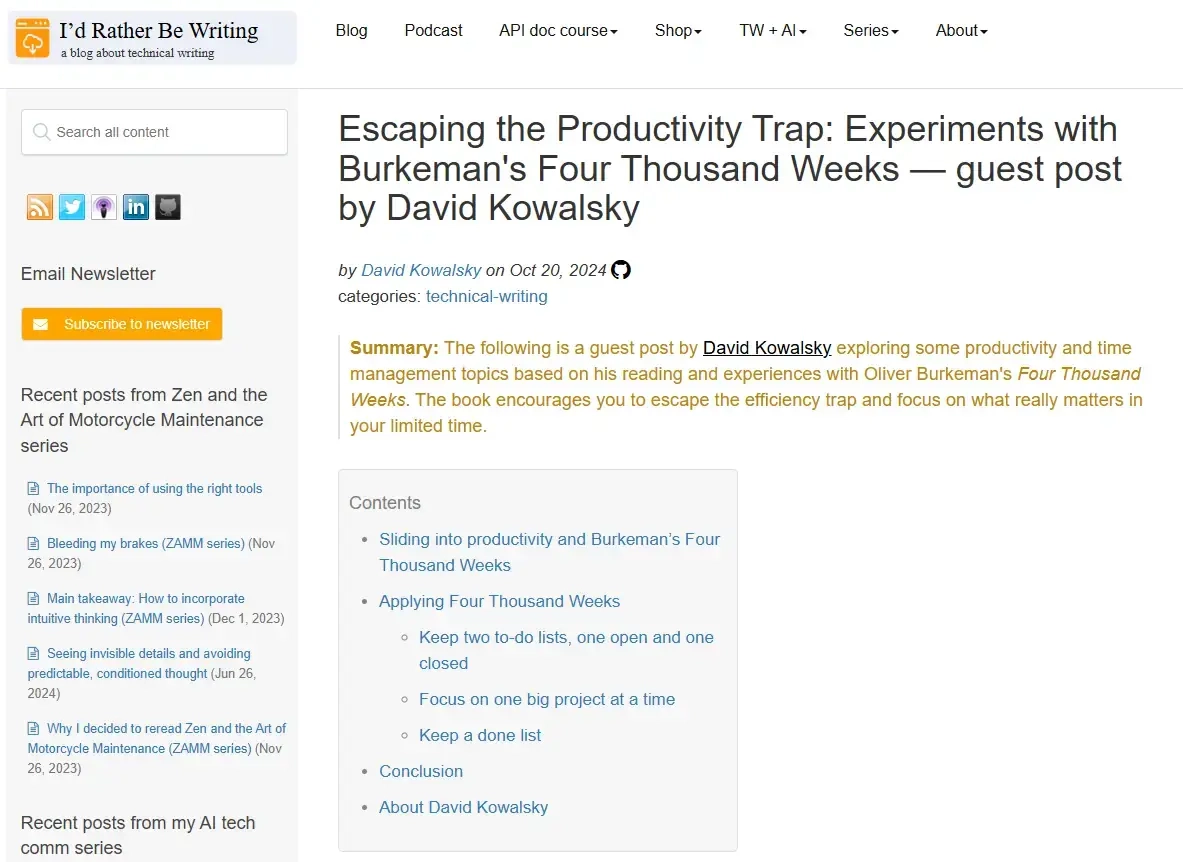
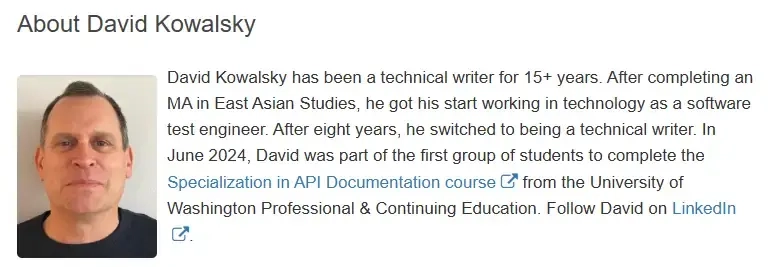
How to Spot Low-Quality Blogs
It’s vital to avoid poor-quality posting services. These websites usually lack any editorial standards, charge for guest posts, or publish content on any subject without a clear focus on any particular niche.
It’s easier to produce content for this kind of website, but Google won’t consider it a high-quality backlink.
Avoid sites with a lower authority score than yours, as you don’t want to put a lot of effort into producing a post only to gain little to no increase in your page ranking.
6) Find Unlinked Mentions
Unlinked mentions are a great way to build quality backlinks with relatively little effort. This strategy involves finding instances where your website, business, or content is referenced but has not been linked to.
Most of the time, this happens because the website owner forgot, and they are usually happy to add the link when asked.
Here’s an example of an unlinked mention, where the creator of the blog has listed the top safest cars in 2025 but hasn’t linked back to any of the brands:
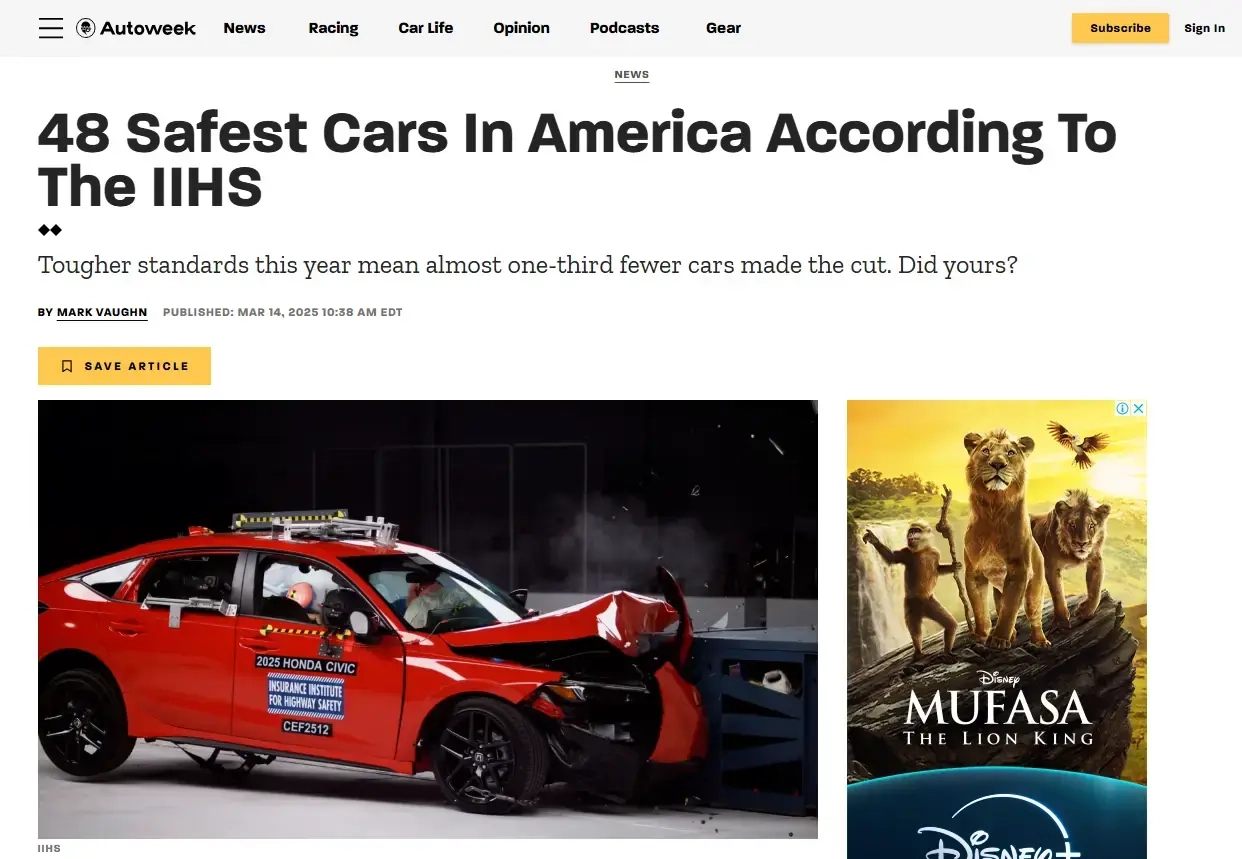
Unlinked mentions can be a goldmine for getting high-quality backlinks because they are:
Relevant: Unlinked mentions often occur on websites that are relevant to your niche. These mentions occur naturally and are contextually appropriate, making the backlinks more valuable for SEO.
Natural: This happens when someone mentions your business or content because it adds value. It indicates that your content is seen as an authoritative resource, which is why they chose to reference it in the first place.
Easy to earn: Since the mention is already there, getting it linked involves minimal effort compared to other link-building strategies.
➡️ How to find unlinked mentions
Below are the steps to follow to spot unlinked mentions and turn them into high-quality backlinks:
Go to Google Alerts.
Set up notifications for your company name, product, or any branded terms.
Choose how often you want to be notified.
When you receive a notification, go to the page to find out where the site mentioned you and whether or not they linked to you.
If the site didn’t link to yours, contact the person who wrote the article and ask for a link.
7) Submit Your Content to Resource Pages
A resource page is a page on a website that curates valuable links and resources on a specific topic.
These pages are designed to provide readers with a one-stop destination for high-quality, informative content related to their interests, for example:

Resource pages are a great source for high-quality backlinks because they often come from reputable websites with high domain authority. Being featured on a well-respected resource page enhances your credibility and authority in your niche.
However, resource pages typically have high editorial standards and only link to the best content. Your content needs to be as good as or better than the other content listed on the page.
➡️ How to submit your content to resource pages
The first step is to find resource pages to target.. Use Google search operators to locate these pages. For example, you can use queries like:
Your keyword + “inurl:resources”
Your keyword + “intitle:resources”
Your keyword + “useful links”
Here are some of the resource pages that show up when we used the Google search operator digital marketing “inurl:resources”:
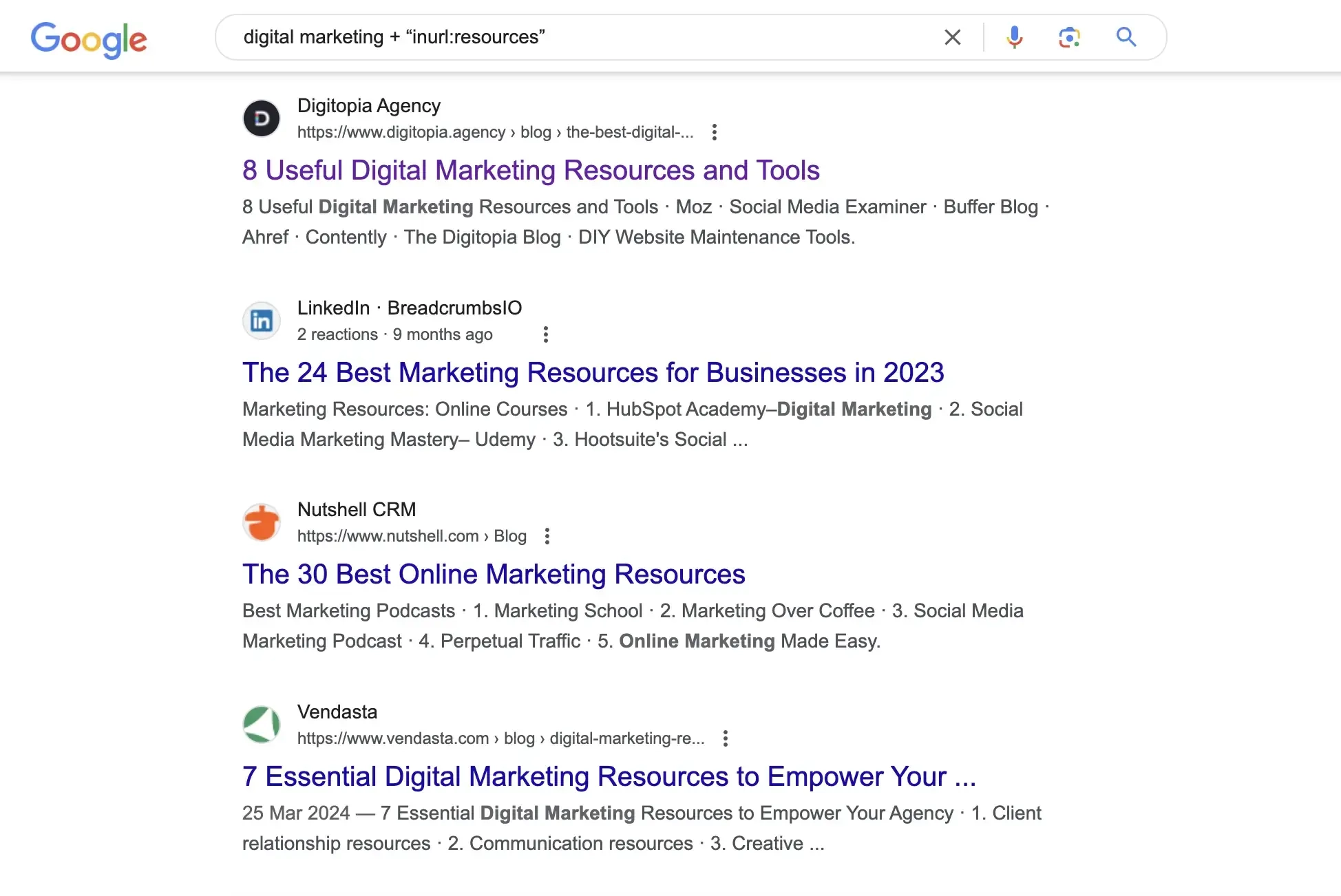
It’s important to ensure the pages you target have high domain authority and are relevant to your content.
Let’s check the DR score of one of our top search results: Nutshell:
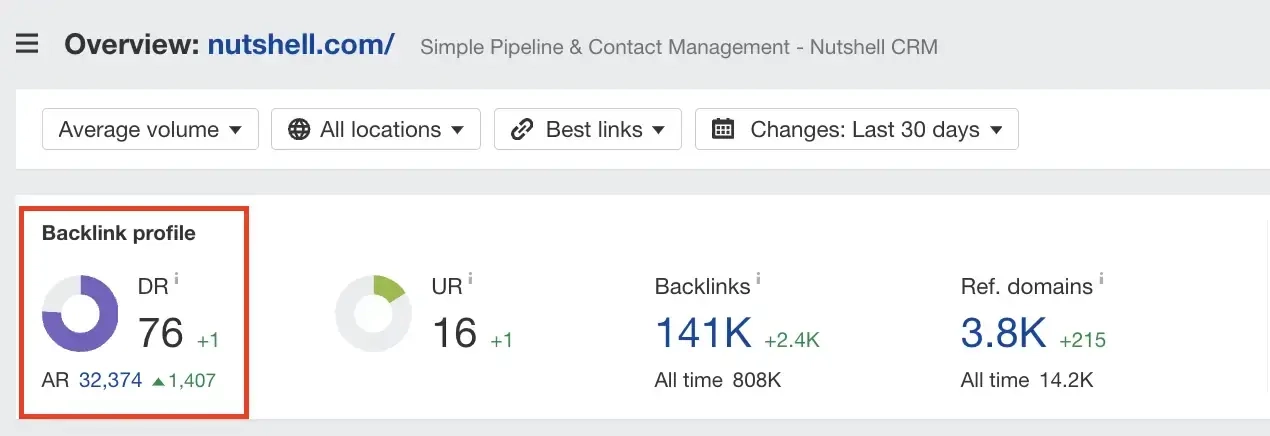
Once you’ve determined that your target resource page is relevant and has a high DR score, review its content and assess whether you have or can create content that would improve it or add additional value.
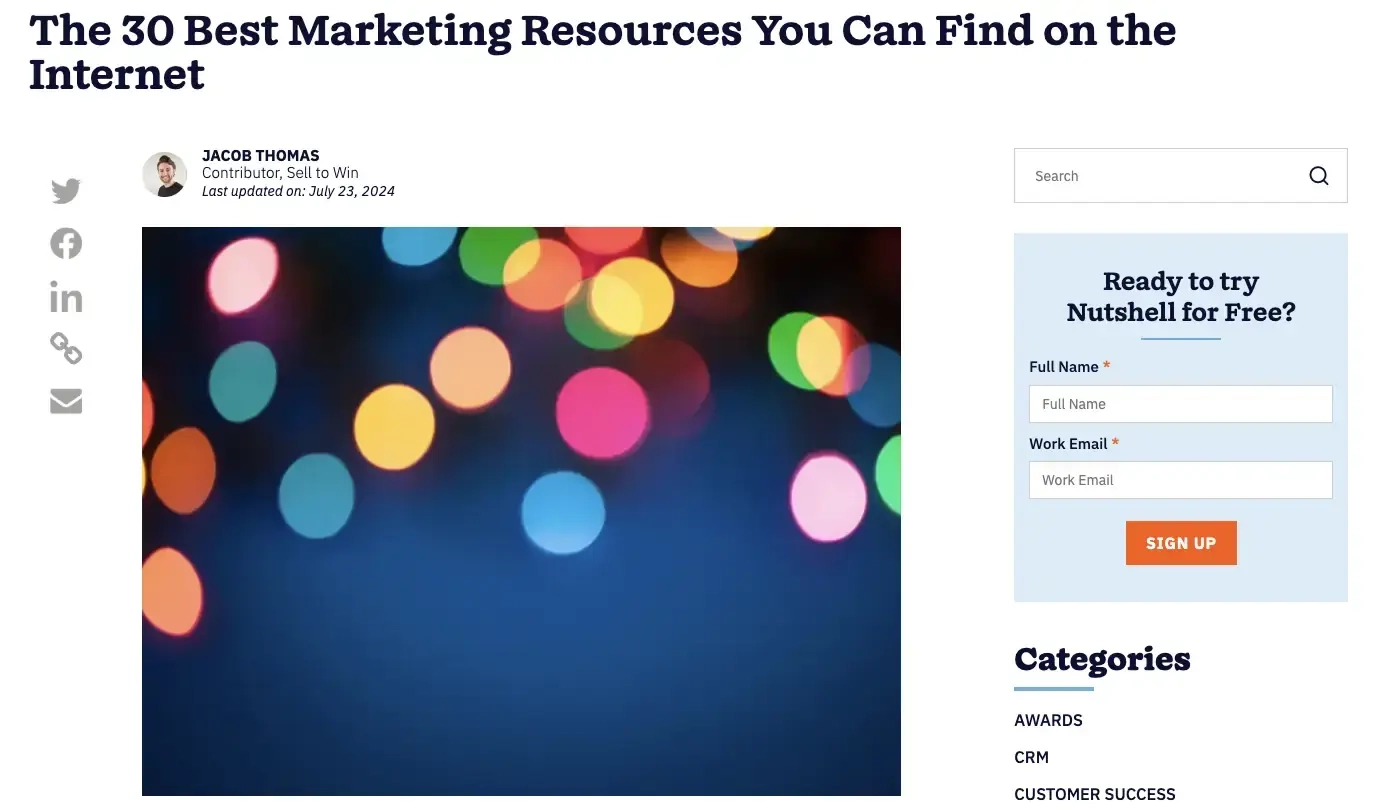
In this example, Nutshell’s page lists digital marketing resources that include:
Podcasts.
YouTube channels.
Blogs.
Once you’ve found or created content that is worthy of inclusion, the next step is to contact the website owner.
When reaching out to the site owner or editor, ensure your email is personalized and highlights the value of your content. Clearly communicate the value of your link and how it aligns with the existing content they feature.
After your content is featured, engage with any traffic or comments it generates to build relationships within your niche.
Boost Your Search Engine Rankings with High-Quality Backlinks
Earning high-quality backlinks is super important if you want to boost your search engine rankings and build an excellent backlink profile.
Getting quality backlinks for your website may seem like a lot of work. But the backlinks you create using the techniques in this article will be more effective than those you would generate via blackhat link-building strategies or by buying links.
This will benefit your website in the long run. Google will begin to see it as a trusted source of content that deserves to rank higher in its SERPs, ultimately driving more traffic to your website.
Are you ready to build high-quality backlinks that actually move the needle? At Linkbuilder, our expert team can help you earn high-quality, white-hat backlinks that drive real results.
Whether you’re looking to boost rankings, build authority, or increase organic traffic, we can help. Get in touch today, and let’s earn you the high-quality backlinks you deserve!
The days of SEO being a game of outsmarting algorithms are over. Today content strategy and valuable, sustainable strategies are essential, not just tricks and links.


